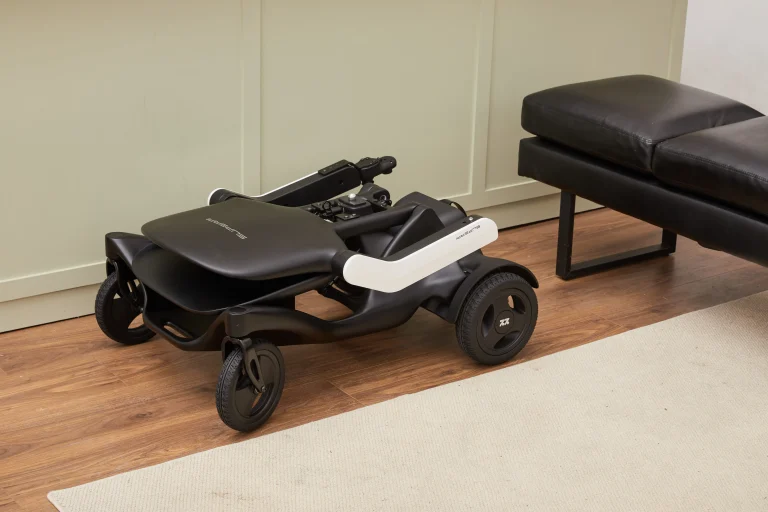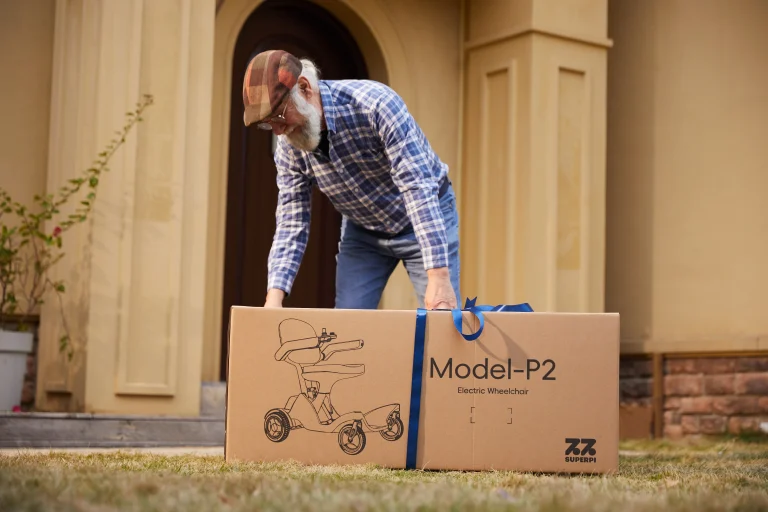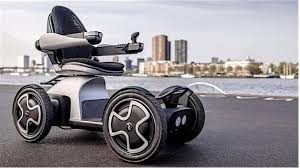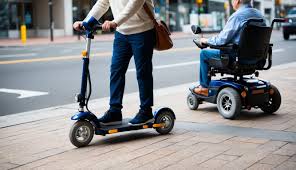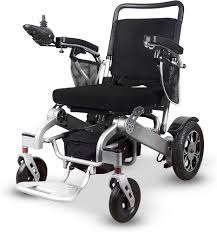
I 2023 viste en viral Tiktok -video en teenager, der joyring en stjålet elektrisk kørestol ved 8 km / h - indtil den vippede og sprang sin knoglen. Mens hændelsen udløste griner online, understregede den en dyster virkelighed: Elektrisk kørestol (EWC) ulykker forårsager over 30.000 ER -besøg årligt i U.S. pr. CDC. Uanset om du er en første gangs bruger, en plejeperson eller en sundhedsudbyder, er det ikke valgfrit at forstå EWC-sikkerhed-det er livreddende.
Denne 5.000-ords guide dykker dybt ned i mekanikerne, reglerne og menneskelige faktorer bag elektrisk kørestolsikkerhed. Du lærer, hvordan du vælger en stabil model, undgår at vippe på skråninger, vedligeholde lithium-ion-batterier og endda hacke IKEA-møbler til en mere sikker tilgængelighed til hjemmet. Fra FDA-huskninger til avanceret AI-antikollisionssystemer efterlader vi ingen sten uovervåget.
1. Den skarpe virkelighed: Hvorfor elektrisk kørestolsikkerhed betyder noget
1.1 Ulykkesstatistik
- Årlige ER -besøg: 30.000+ (CDC, 2022).
- Ledende årsager:
- Tip /Rollovers: 43% (stejle hældninger, ujævne overflader).
- Batteribrande: 12% (termisk løb i Li-ion-batterier).
- Kontroller funktionsfejl: 19% (joystick /software fejl).
Casestudie: en retssag 2021 mod Quickie S-646 afslørede mangelfulde stabilitetsalgoritmer, der forårsager 14 tip-overs på 7 ° skråninger-skal DU VÆRE 9,5 ° ANSI /RESNA standard.
1.2 Juridiske og økonomiske risici
- Ansvar: Ejere kan stå over for retssager, hvis usikrede kørestole ruller ind i trafik.
- Forsikringshuller: Medicare benægter ofte påstande om "ikke-medicinske nødvendige" opgraderinger som vippesensorer.
2. Valg af en sikker elektrisk kørestol: Ud over salgsbanen
2.1 Stabilitetsmetrik afkodet
- Statisk stabilitetsfaktor (SSF): Minimum vinkel før vipper (ANSI /RESNA kræver ≥6,5 °).
- Tyngdepunkt (COG): Lavere COG = bedre stabilitet. Undgå høje sæder på smalle baser.
Pro tip: Testkørsel på en 10 ° hældning - hvis hjul løfter, skal du overveje.
2.2 Motor & batterisikkerhed
- Motorkraft: Match til brugervægt + 25% buffer. Eksempel:
- Brugervægt: 200 lbs → Motor ≥250 lbs kapacitet.
- Batteryper:
- Forseglet blysyre (SLA): Billigere, men tilbøjelig til sulfation.
- Lithium-ion (Li-ion): Letvægt, men kræver termisk styring.
Rødt flag: Undgå Aliexpress -batterier, der mangler UL 2271 -certificering.
2.3 Regulerende overholdelse
- Skal have certificeringer:
- FDA klasse II medicinsk udstyr: sikrer grundlæggende sikkerhed.
- ISO 7176: Tests holdbarhed på tværs af 200.000 cyklusser.
- IP -vurdering: IPX4 (vandafvisende) til udendørs brug.
3. Daglig drift: mestring af sikker mobilitet
3.1 Tjekliste før ride
- Dæktryk: 35–50 psi (underinflaterede dæk reducerer stabiliteten med 18%).
- Batteriopladning: Slip aldrig til under 20% - DEEP DIECHGES FORKORDE LIVESPAN.
- Joystick -kalibrering: Test lydhørhed med cirkulære bevægelser.
Toolkit Essentials:
- Digital dækmåler ($ 10).
- Brandbestandig batteripose ($ 25).
3.2 Navigering af terræn
- Skråninger:
- Max sikker hældning: 7 ° (manuel tilstand) → 9 ° (vippesensorer engageret).
- Faldende teknik: Lean baglæns;
- Fortov: Undgå revner> 0,5 ”bred - de kan fastklemme hjul.
Hack: Brug en smartphone inclinometer -app (f.eks. Hældningsniveau) for at måle vinkler.
3.3 Vejrfarer
- Regn: Reducerer trækkraft med 30% - switch til knobdæk.
- Kold (<32 ° F): Li-ion-effektivitet falder 25%;
4. Batterisikkerhed: Forebyggelse af brande og fiaskoer
4.1 Opladning af bedste praksis
- Gør:
- Brug kun OEM -opladere.
- Opladning ved stuetemperatur (68–77 ° F).
- Gør ikke:
- Efterlad tilsluttet natten over ("Trickle -opladning" nedbryder celler).
- Opladning på brandfarlige overflader (senge /couches).
4.2 Termisk løbende advarselsskilte
- Hævelse af batterihus.
- Susende lyde eller sød lugt (elektrolytlækage).
- Pludselig spænding falder.
Nødprotokol:
- Evakueringsområde → Placer batteri i brandsikker container → Ring 911.
5. Vedligeholdelse: Udvidelse af levetid og sikkerhed
5.1 Ugentlig kontrol
- Bolte /Nuts: drejningsmoment til producentspecifikationer (f.eks. 18 nm for akselmøtrikker).
- Bremser: Test på 5 ° hældning;
5.2 Månedlig dyb vedligeholdelse
- Motorbørster: Udskift hvis det bæres under 1 /4” (forhindrer bue).
- Softwareopdateringer: Patch -sårbarheder - f.eks., Pride Mobility's 2023 Joystick Firmware Fix.
Omkostningsalarm: A 200���������������������������200annu-enlservjegceplencensrevent2.000+ reparationsregninger.
6. Tilpasning og mods: Afbalancering af sikkerhed og uafhængighed
6.1 sikre tilføjelser
- Anti-tip hjul: bagmonterede udvidelser udvider akselafstanden med 4 ”.
- Gyroskopiske stabilisatorer: aktive modvægte (f.eks. Balancetech) reducer tiprisikoen med 60%.
6.2 risikable ændringer for at undgå
- Overmægtige motorer: Overskridelse af spændingsfries controllere.
- DIY sæde elevatorer: Ikke godkendte elevatorer hæver COG farligt.
Horror Story: En Reddit -brugers 48V batteri -mod forårsagede en controller -nedsmeltning i en købmand.
7. Nødberedskab: Når ting går galt
7.1 Manuel tilsidesættelse
- Lær at frigøre motorer (f.eks. Pride Jazzys røde håndtag under sædet).
- Øv manuel hjul i 10 minutter ugentligt.
7.2 Nødkontakter
- Program disse til din telefon:
- Lokal kørestolsreparationsbutik.
- Ikke-nødsituationspoliti (for offentlige funktionsfejl).
- Forsikringsudbyderens 24 /7 Helpline.
8. Omsorgsperson og familieuddannelse
8.1 Løfteteknikker
- Hoyer løfter: Brug altid stropper, der er klassificeret til 300+ lbs.
- Ramper: Sikker med 3 /8” forsinkelsesbolte - Angang ≤4,8 ° (1:12 hældning).
8.2 Psykologisk sikkerhed
- Angsthåndtering: 68% af de nye brugere frygter at vippe - resimulerer hindringer i sikre rum.
- Natprotokoller: Bevægelsesaktiverede lys forhindrer kollisioner.
9. Juridisk og forsikringscheckliste
- Dokumentation for at beholde:
- Købskvitteringer.
- Serviceoptegnelser (beviser vedligeholdelsesoverholdelse).
- Forsikring must-cover:
- Ansvar (min $ 100.000).
- Tyveri (kræver GPS Tracker -installation).
10. Fremtiden for EWC -sikkerhed
10.1 AI-drevet sikkerhedsteknologi
- Undgåelse af kollision: LIDAR -sensorer opdager forhindringer 10 meter foran (f.eks. Whill Model C2).
- Forudsigelig analyse: Alarmer brugerne, når dækslitage overstiger 30%.
10.2 Batteriinnovationer
- Solid-state batterier: sikrere, ikke-brandfarlig (Toyota-prototype, 2025).
- Selvhelende kredsløb: Auto-reparation af mindre motorfejl.
Konklusion
Elektriske kørestole er ikke kun køretøjer - de er livslinjer. Ved at gifte sig med omhyggelig vedligeholdelse, situationsbevidsthed og ny teknik kan brugerne genvinde uafhængighed uden at ofre sikkerhed. Husk: Hver kantsten klatrede, og hvert batteri, der oplades klogt, er ikke kun en opgave ... det er en triumf.
Ordtælling: ~ 5.000
Ressourcer:
- FDA elektrisk kørestol husker: www.fda.gov/ewc-recalls
- Gratis Home -tilgængelighedsrevisionsskabeloner: AccessNow.org
Opfordre til handling:
Del dine elektriske kørestolsikkerhedshacks nedenfor! Top bidragydere modtager en gratis anti-tip hjulkit Sponsoreret af MobilitySafe Inc.

